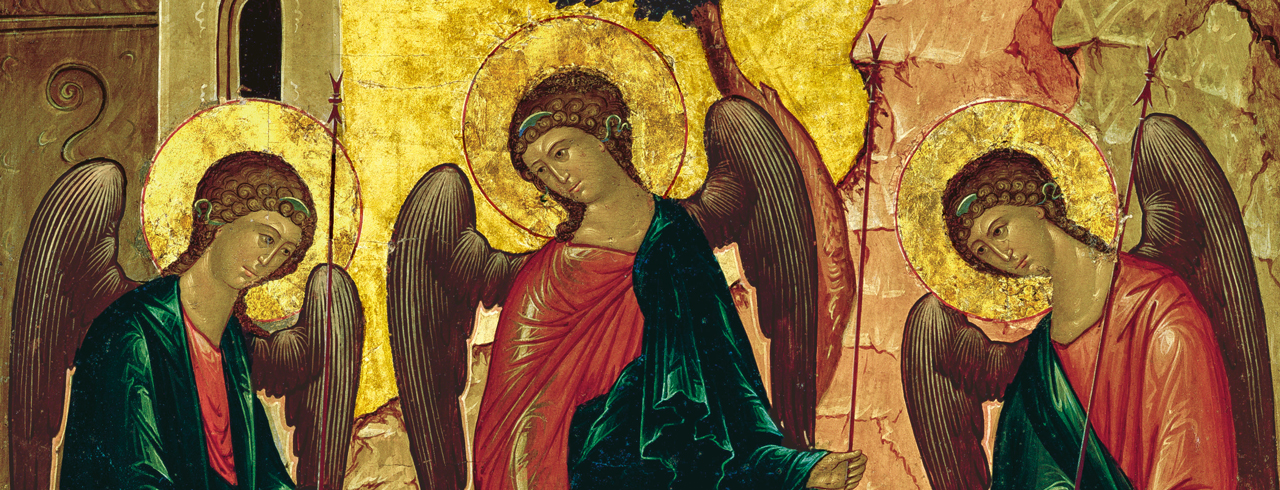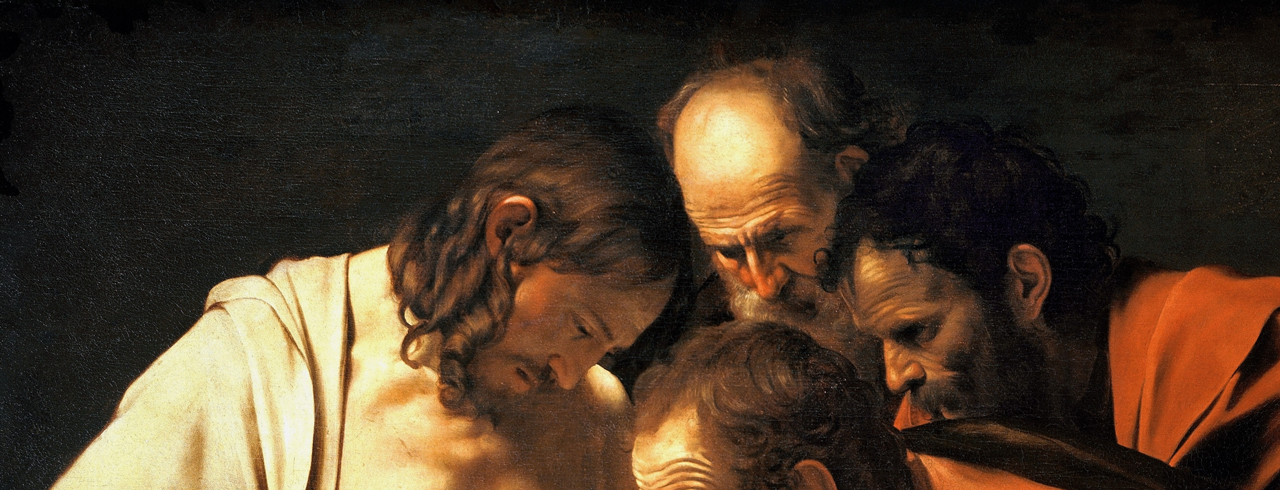-
Discover Magnificat
All you need to know about Magnificat
-
Subscribe to Magnificat
Subscribe, renew or offer a subscription

Every Icon Is the Icon of Christ
Pierre-Marie Dumont

The Incredulity of Saint Thomas (1601–1602)
Michelangelo Merisi da Caravaggio (1571–1610)
Caravaggio’s Incredulity of Saint Thomas was meant to make us uncomfortable. We are interrupting a private moment, and there seems to be no way to gracefully escape. Perhaps we could hide unnoticed amid the shadows, but Caravaggio’s tight composition with few participants would immediately reveal our intrusion. There is nothing to do but join this intent company. The four heads form a cross, recalling that a little over a week earlier, Jesus was crucified, died, and was buried. Yet the tall, luminous figure of Christ draws us to him together with Thomas, Peter, and John. Still wrapped in what looks like his shroud, Jesus is bathed in light pouring over him from an unseen source above. The chiaroscuro technique accentuates the human flesh over bone and muscle: a very real body. We follow the gaze of the apostles to the core of the composition, where Thomas’ finger is probing the wound in Christ’s side. Our instinct is to recoil. The dirty finger of this unkempt man is lifting the flesh around the laceration. The tear in Thomas’ shirt mirrors the wound, recalling the spear that ripped through Christ’s side at the crucifixion. Graphic and disturbing, yet it’s impossible to look away.
Daring patrons
Caravaggio’s startling composition came out of left field. Roman art did not have much of a tradition in the subject, although there was an altarpiece by Domenico Passignano in Saint Peter’s Basilica. By contrast, several artists in Venice and Florence had explored the theme, as did numerous manuscript illustrators. Some artists focussed solely on Christ and Thomas, as in Verrocchio’s beautiful bronze statue group outside Florence’s Orsanmichele, where Jesus appears recessed in the niche, more distant from the viewer as Thomas approaches. Others depicted the complement of apostles giving Thomas a wide berth, as in Duccio’s Maestà. Albrecht Dürer’s engraving showed Thomas’ hand inserted into Christ’s side, heralding Caravaggio’s version, but the Milanese painter went further, appearing to open a gaping wound in space to suck us into this drama.
The work is believed to have been commissioned by Vincenzo Giustiniani, a wealthy Genovese banker, who with his brother Cardinal Benedetto Giustiniani was among Caravaggio’s greatest supporters and was instrumental in helping him obtain major public commissions. The brothers were deeply immersed in the Counter-Reformation culture of the age, actively promoting art as a compelling means to transmit truths of the faith. Caravaggio’s aggressive style of juxtaposing hyper-realistic details with supernatural light, disregarding perspectival depth in favour of figures jutting towards the viewer, and of leaving blank pictorial spaces to be filled by the beholder, appealed to these avant-garde collectors who were attempting to rekindle faith through art. Caravaggio’s Incredulity was so popular that many copies were made of the work, at least one by the master himself for an equally prestigious patron.
Our twin
Caravaggio’s innovative vision of Saint Thomas addressed head-on one of the greatest challenges of the 17th century: doubt. Of course, doubt was never alien to Christianity, but the Protestant Reformation and the printing press offered believers a multiplicity of new teachings, while the Age of Discovery encouraged people to place their trust in the empirical rather than the divine. Sacraments, -especially the Eucharist, were questioned, and scepticism clouded belief. Patrons like the Giustiniani appreciated Caravaggio’s fearlessness in confronting these controversies through his art. Looking at this work, we can see that Caravaggio left a seemingly blank space between the bodies of Christ and Thomas, directly in our path as we approach the work. This space invites us to join Thomas Didymus, our “twin”, with all our doubts and questions. We look at his astounded face: he has seen and he has believed. Above, the apostles join us in our wonder; do we really believe that when Jesus was showing his wounds to Thomas the others remained aloof? We all want to see, to touch, to know, and the Church understands that. As Benedict XVI wrote, “Faith can only mature by suffering anew, at every stage in life, the oppression and the power of unbelief.” The cure for this doubt is humility, represented by the apostles with their somewhat dull expressions and tattered clothes, an interesting mirror for the urbane, elegant Giustiniani who would have stood before the work.
Once we have found our place in the painting, and accepted our own doubt and desire, we are ready to look up towards the shadowed face of Christ. His hand guides Thomas to the truth, his gentle expression revealing the love he has for us even in our own wounded, conflicted state. At this point, Caravaggio has drawn us so deeply into the scene that there is nowhere for us to go and nothing for us to say, except to echo Saint Thomas: “My Lord and my God.”
Elizabeth Lev
Writer and professor of art history in Rome.
The Incredulity of Saint Thomas (1601–1602), Michelangelo Merisi da Caravaggio (1571–1610). Picture Gallery Sanssouci, Prussian Palaces and Gardens, Foundation Berlin-Brandenburg, Potsdam, Germany. © Bridgeman Images.
(Read More)




On 25 July, we celebrate the 1,700th anniversary of the conclusion of the first ecumenical council in history. Convoked in Nicaea in 325 by the Emperor Constantine, it played a crucial role in defining the Trinitarian doctrine: one God in three co-equal Hypostases (Persons). Along with the Council of Constantinople in 381, it gave the Church her “Symbol” or profession of faith, the Niceno-Constantinopolitan Creed. On this occasion, we recommend contemplating the mystery of the Holy Trinity by examining the remarkable icon that adorns the cover of this issue of MAGNIFICAT.
Produced in the 15th century in Novgorod (124 miles south of Saint Petersburg), this icon is entitled The Holy Trinity (Svyataya Troitsa in Old Slavonic). It depicts as a theophany (manifestation of God) Abraham’s hospitality, related in the Book of Genesis (18:1-10; see pages 302-303). Abraham and Sarah in the foreground serve their three guests, who are seated at table beneath the oak of Mamre (today Hebron in Israel). Having revealed that they were sent by God to announce that Abraham and Sarah, despite their advanced age, will bring into the world the son of the promise (Isaac), they are depicted as angels, with wings.
The Fathers of the Church, meditating on this episode from Genesis, also saw in it a veiled revelation of the mystery of the Trinity, one God in three Persons. The first three words of the account are: The Lord/ appeared/ to him, and thus they designate the one God. Then the account in fact enumerates three visitors, but when Abraham addresses them, he speaks to them in the singular: My Lord…. Nevertheless he asks Sarah to prepare three wheaten cakes, which the visitors (in the plural) eat. Then they ask to see Sarah. But when they speak again, the account returns to the singular: The Lord said…. And throughout the following conversation, the traveller is called the Lord [God]. Finally, the account concludes in the plural: The men set out from there.
Inspired by the meditations of the Fathers of the Church, early Christian artists, and then iconographers, have been fond of suggesting the Trinity by depicting the hospitality of Abraham; they go so far as to show the Trinity at work in salvation history, from the creation of the world to the new and eternal covenant, via the covenant with Abraham. We will “read” this icon by reviewing the stages of the Trinitarian manifestations in human history.
In the foreground, Abraham serves three bread-rolls, the first sign of the Trinity, and Sarah serves the bloody flesh of the young animal that has been sacrificed, prefiguring the sacrifice of Isaac, then of Christ. The three visitors are seated at table; they wear the same clothes (although arranged differently, in personalised ways), hold in their left hand the same rod-sceptre of omnipotence (the merilo), and with their right hand bless the table in the same gesture. Their faces show the same features and the same expressions. There is no better way the artist can suggest they represent one God in three equal Persons. The posture of the three Persons, however, suggests their perichoresis (unifying relations of love): the figure of the Holy Spirit (to the viewer’s right) and the figure of the only-begotten Son (in the centre) are turned toward the figure of the Father (to our left).
In the background, looming over the figure of the Holy Spirit and leaning toward the representation of the Trinity, the “high mountains” testify that the scene is indeed a theophany. They also proclaim the future theophanies on Sinai and Mount Tabor. In the centre, the tree is the oak of Mamre. It recalls the paradisiacal tree of the knowledge of good and evil, and being situated behind the figure of the Son—the Saviour who is to come—it announces the tree of the cross. Now, to our left, directly over the figure of the Father, we see Abraham’s dwelling place, depicted as a house. It prefigures the Temple in Jerusalem (in my Father’s house, Jesus will say), then the Church of Christ, and finally heaven: In my Father’s house there are many mansions (Jn 14:2, Douay-Rheims).
At the centre of the picture, the table of hospitality has pride of place. It suggests the altar of the Old Covenant sacrifices, then the Eucharistic altar of the New and eternal Covenant. For this purpose, the iconographer shows the little window of the confessio, where the early Christians would place the relics of a Confessor of the faith (a martyr). The Son stands at the altar, on which a vessel filled with wine evokes the Last Supper and the Sacrifice of the Mass. And, indeed, when the fullness of time has arrived, the Second Person of the Holy Trinity will become man, and then, as proof of his unsurpassable love, he will freely become once and for all the One who offers and the One who is offered.
Pierre-Marie Dumont
The Holy Trinity, Novgorod School, 15th c., Museum of Art, Novgorod, Russia. © Bridgeman Images.
(Read More)